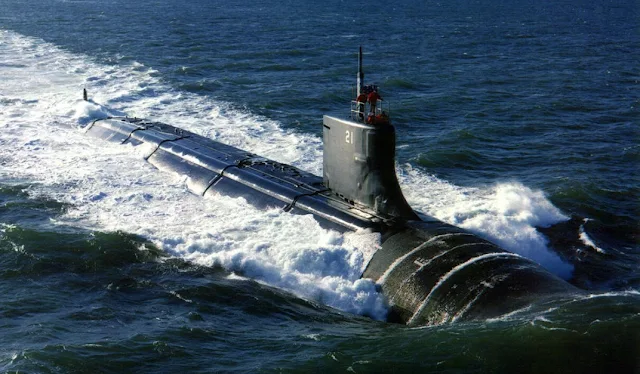 |
| Sad Facts The US Navy Only Has 3 Units Seawolf Class Submarines |
International Military - Although it can be the best military title in the world, but the US turns out to have a very fatal weakness. Apparently the US Navy only has three Seawolf class submarines. Why are there so few Seawolf Class submarines?
In the Universe, "sea wolf" is another name for the Atlantic Wolf Fish (Anarhichas lupus), a rather monstrous-looking sea creature that survives in waters with temperatures as low as -1 to 11°C. It preys on hard-shelled crustaceans, molluscs, and echinoderms. .
The animal's namesake in the world of nuclear-powered fast attack submarines (SSNs), the US Navy's Seawolf-class submarines, can also survive in frigid waters. They are deadly predators for potential enemies sailing the seas.
However, the Seawolf submarine may also qualify for the Endangered Species List due to the fact that very few were built, especially in relation to how many are planned.
Spawn Seawolf Subs
The Seawolfs (or were they Seawolves?) were conceived as the intended successors to the venerable US Navy Los Angeles-class SSNs, which were commissioned between 1974 and 1996.
Design work on the Seawolf class at General Dynamics Electric Boat began at the height of the Cold War in 1983, with the aim of competing with Soviet ballistic missile submarines (SSBNs) such as the Typhoon class and attack submarines such as the Akula class.
However, the collapse of the Soviet Union and the resulting "peace dividend" threw a proverbial wrench into the work and raised serious doubts about the future viability of the Seawolf project. As the Seaforces-online website describes as follows.
“A fleet of 29 submarines will be built over a ten-year period, but it is reduced to 12 submarines. The end of the Cold War and budget constraints led to the cancellation of further fleet additions in 1995, leaving the Seawolf class limited to just three ships. This, in turn, led to the smaller Virginia-class design. The Seawolf class costs about $3 billion per unit ($3.5 billion for the USS Jimmy Carter), making it the most expensive SSN submarine and the second most expensive submarine ever, after the French SSBN Triomphant class The projected cost for 12 submarines of this class is $33 .6 billion."
To put those numbers into perspective, 62 Los Angeles-class submarines were built at a per-unit cost of $1.6 billion in 2020 dollars. Meanwhile, 22 of the planned 66 Virginia-class SSNs have been completed so far, with a unit cost of $2, 8 billion.
Seawolf Class Submarine Capabilities and Specifications
 |
| US Navy Seawolf Class Submarines |
Given that mind-numbing expense, it's easy to forget that the Seawolf-class submarines are some truly impressive battleships. While they lack the firing tubes of the Los Angeles-class Vertical Launching System (VLS) cruise missiles, the Seawolfs have twice the number of torpedo tubes as their eight-versus-four predecessors and are larger, quieter, and faster.
However, lacking VLS canisters, they have a capacity of up to 50 UGM-109 Tomahawk cruise missiles to strike sea and land surface targets. Additional armament consists of Mk-48 Advanced Capability (ADCAP) torpedoes and UGM-84 Harpoon anti-ship missiles.
In terms of durability and survivability and perhaps as a way of upgrading the Typhoon's hull with double titanium the Seawolf class hull is made of HY-100 steel, which is stronger than the HY-80 steel used in the old factory, to withstand water pressure at great depths. bigger.
The official test depth is 1,699 feet. To address the opposite end of the depth spectrum, Seaforces-online states that “the boat also has extensive equipment to enable shallow water operations. This class uses the more advanced ARCI Modified AN/BSY-2 combat system, which includes a larger spherical sonar array, wide aperture (WAA) array, and new towed array sonar.
Each ship is powered by one S6W nuclear reactor, delivering 45,000 hp (34 MW) to a low-noise pump jet. In terms of durability and survivability and perhaps as a way to upgrade the Typhoon's hull with double titanium the Seawolf class hull is made from HY-100 steel, which is stronger than the HY-80 steel used in the old factory. grade, to withstand water pressure at greater depths.
The official test depth is 1,699 feet. To address the opposite end of the depth spectrum, Seaforces-online states that the boat also has extensive equipment to enable shallow water operations.
This class uses the more advanced ARCI Modified AN/BSY-2 combat system, which includes a larger spherical sonar array, wide aperture (WAA) array, and new towed array sonar. Each ship is powered by one S6W nuclear reactor, delivering 45,000 hp (34 MW) to a low-noise pump jet.
The first two ships in the Seawolf class were USS Seawolf (SSN-21) and USS Connecticut (SSN-22), commissioned on July 19, 1997 and December 11, 1998, respectively. They sport a hull length of 353 feet (108 meters), beam width 40 feet (12 meters), and a draft of 36 feet, and a submerged displacement of 9,138 tons.
The third and final ship of the class, the USS Jimmy Carter was named for a 1947 U.S. Naval Academy graduate who served as a submarine officer under the strong-willed leadership of Admiral Hyman G. Rickover had an additional hull length of 100 feet and a displacement weight of 3,002 tons due to the insertion of a section known as a Multi-Mission Platform (MMP) that enables the launch and recovery of remotely operated underwater vehicles (ROVs) and Navy SEALs.
The three Seawolf ships carry a crew complement of 140 (14 commissioned officers and 126 enlisted sailors) and boast a maximum speed of 35 knots, with a rest speed of 20 knots. So far no Seawolf class submarines have been used in combat.
But given the growing hostility emanating from Russia, China, and North Korea, these predatory fish of their mechanical namesake may well get their first "bloodbath" sooner rather than later, and thus prove themselves worthy of the hefty price tag.
